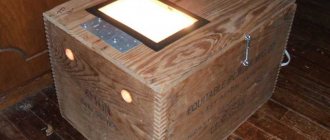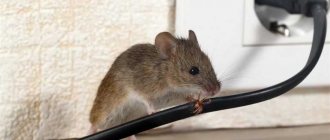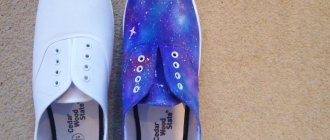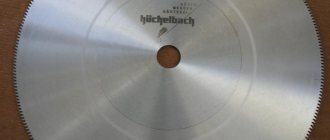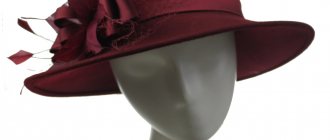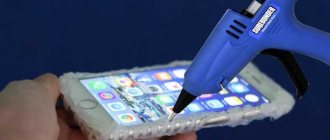During the rainy and slushy season, I really missed a shoe dryer at home. I didn’t risk drying my boots on radiators and radiators, but buying a special product is too expensive. Therefore, I came to the conclusion that I needed to come up with something on my own. Then the thought came to my mind: why not make a dryer from polypropylene pipes. I still have plenty of them after soldering the heating. Let's get straight to the point.
Source goods.ru
Advantages of a homemade dryer
Electronic goods stores can offer each customer a huge collection of ready-made electrical installations for drying shoes. However, homemade designs have a lot of advantages in use:
- The ability to independently adjust the shape and size.
- It can be built from a wide variety of materials, which are sure to be found in the household of every zealous home owner.
- Dry shoes quickly, but without direct exposure to high temperatures.
- Prevention of the formation of pathogenic fungus and long-term treatment of foot diseases in the future.
Most electric and simple shoe dryers are compact in size, occupying a small area in the hallway.
The advantages of choosing homemade designs include a large number of available instructions on how to make a shoe dryer with your own hands, video lessons and diagrams for work.
Tools and materials
Due to the fact that the shoe dryer is made by hand, its cost will be much lower. Therefore, you need to choose materials from available means. This could be remnants of pipes, strong wire, construction tape, terminals, heating elements . Some materials and tools will have to be purchased, but in general, a homemade shoe dryer should be inexpensive but functional.
Requirements for a homemade dryer
Any home structure, especially electrical, must meet a number of requirements:
- Compact size and convenient shape. The upper platform must have a flat surface or a fixing part to hold boots, sneakers, and shoes in one position.
- When installing electric dryers, you should take care of safety in advance. The user should not have direct contact with the electrical network to avoid thermal burns.
- You should also consider the location of the electrical installation in order to limit the child’s access to it as much as possible.
All assembly work should be carried out according to a previously prepared drawing, so as not to make gross mistakes and not to disrupt the electrical circuit of the device.
Marking the holes
I use a tape measure to measure the fan and mark on the plywood the place for its placement strictly in the center. Then I mark the corners where I will drill holes for the air ducts.
Master classes on making a dryer
Today there are a huge number of ways to assemble an original dryer for outdoor shoes: from the simplest to complex electric models. Such devices can be used for one pair or intended for several wardrobe items (large drying shelves).
At home, you can create not only complex devices, but also simple design models. For example, wooden or plastic dryers with a built-in hairdryer (through a hollow pipe system) are especially popular.
These can be accessories without additional supply of hot air or water. Such models are simpler to implement, however, the process of drying shoes takes a long time (and the quality of the material suffers).
Types and features of dryers
Specialized units are heavy, designed to dry several pairs of shoes at once, and are characterized by large dimensions and weight. In principle, you can dry any shoes on them. A dryer with long tubes is ideal, through which dry warm air is supplied to the insole, quickly removing moisture from the hygroscopic internal materials of rubber, tarpaulin, and polyvinyl chloride boots. Just like the materials of ski boots, they require strict adherence to thermal conditions.
Public dryers consist of:
- electric heating element hidden in the rack;
- several rows of hollow tubes on which boots and shoes are put on;
- an ultraviolet element that allows you to disinfect shoes, eliminating unpleasant odors;
- regulator of heating intensity and air injection.
In some general use models you can find an operating time timer. This is a good option for drying boots at night.
With equipment dried at the equipped bases of ski resorts, athletes will not have any problems preparing for a new day of active recreation on the slope. For those who came to the mountainous regions as savages, the question of bringing boots into working condition remains open. It is almost impossible to dry shoes efficiently on central heating radiators in a short time.
Attention! When using gas stoves, ovens, or wood-burning stoves, there is always a risk of damage to the materials used to make shoes.
An alternative to modular dryers is lightweight, mobile equipment consisting of a low-power heating element and a fan hidden in an attractive body. It is this plastic element that is at risk of damage during transportation. An important option when choosing a dryer is a deodorizer - an ozonizing or ultraviolet element responsible for eliminating unpleasant odors and destroying the bacteria that cause them.
Simple battery dryer
It is better for novice craftsmen to give preference to the simplest model of a shoe dryer for a radiator, made with their own hands. A similar design is a grille or mesh that is installed on a heating battery.
To make it you will need fittings, an angle grinder, and welding. An excellent solution would be to first draw up a drawing, which necessarily shows the location of the support posts, fasteners for the battery, and a net for drying shoes. The structure is assembled by welding adjacent parts.
At the same time, it is important to strive for the distance from the heat source to the grill to be at least 15 cm. At this height, moisture evaporates uniformly from the fabrics of boots, boots, and sneakers without deformation.
How to properly dry shoes the traditional way
Despite all the devices offered by the industry, they may not always be at hand at the most needed moment. This is where the question arises: how to dry ski boots using improvised means. You will have to use the old-fashioned method, for this you should:
- Take out the insulating sock.
- Get the insole.
- Place on the central or autonomous heating radiator.
- Pour water out of a plastic shoe if it has accumulated under the insole.
- Moving the tongue as far as possible, the boot should be placed with the sole up on a warm radiator.
If water radiators are not available, an oil radiator can be used as a heat source. In extreme cases, air circulation will be provided by a fan heater installed for a continuous cycle of operation in a fixed position at the level of the top of a lying boot. How much dry air will enter the boot depends on the humidity in the room.
Attention! If the boot is heated enough, steam will come out of the boot for a while. Its absence does not indicate complete displacement of moisture from all materials. It’s just that wet materials, regardless of the thickness of the layers, warmed up to the same temperature, and evaporation became less intense.
When operating oil radiators or open fire sources, the air quickly becomes dry, but the amount of oxygen there becomes less. Drying your ski boots properly in the room without experiencing any discomfort is a great success. To dry shoes you need to set aside a separate small room.
Electric pipe dryer
A more complex version of the electric dryer is also available for self-assembly. To work, you will need to prepare corrugated pipes, a stationery knife, heat-resistant glue, wires, and electrical tape.
To install the power supply, you need 2 coolers, a power supply (a 12 V unit is enough), and a cardboard box of the appropriate size. Instructions on how to make an electric shoe dryer with your own hands:
- Assembling the power supply begins with installing the coolers on the bottom of the prepared box. To do this, you can cut two holes of the appropriate diameter and attach the coolers with glue.
- You will also need two holes in the side walls of the box. Corrugated pipes are passed through the prepared holes.
- The next task for the master is to connect the wires. It is important to ensure that when the coolers are operating, air enters the box and is forced into the pipes.
A stand of any shape and size is made from corrugated pipes. They complete the work by connecting the pipes coming out of the box to the finished rack.
Recommendations for storage and care
At the end of the season, before sending the equipment to the mezzanine, the boots must be properly prepared:
- remove and wash the boot insert;
- wash the outside and inside and dry the plastic base of the boot;
- Having collected both components together, you need to stuff your shoes with crumpled newspapers.
By completing the three required steps, you can be sure that mold fungi will not ruin your expensive shoes, and thanks to the tight insert, there is no risk of deformation.
A mezzanine in a room or hallway is the optimal place for storage; the sun’s rays do not penetrate there, which can damage the outer paint layer. Changes in temperature and high humidity also have nowhere to come from.
Water shoe dryer
The latest innovations that can be built at home include a water dryer for outdoor shoes. Instructions on how to make an original and practical heating dryer for shoes with your own hands:
- A section of profile pipe is soldered into the general system through a fitting.
- The pipe is carried to the location of the structure.
- The next step is to install the tap or valve.
- Now it is necessary to organize a closed circuit, for which the pipes are laid in parallel rows and then the ends are soldered (the heating circuit is closed according to this principle).
The final stage is bringing another profile pipe to the soldered section with a fitting. A DIY water shoe dryer has many advantages over other well-known models.
If you need to dry your shoes, just open the valve and let hot water flow through the additional channel. All the advantages of such a model can be appreciated in the photo of a handmade shoe dryer.
Popular models
Portable dryers for one pair of shoes are made taking into account the shape of the sock, which is important when caring for leather and leatherette shoes, but also for rubber boots and ski boots, which do not risk deformation when over-dried. This modification makes it possible to place the dryer in the most difficult-to-reach places for warm air circulation, ensuring uniform heat distribution.
Despite the general similarity, there are differences between light dryers:
- antibacterial with ozone and a sliding body, which makes it suitable for equally effective drying of shoes of small and large sizes;
- RJ-52C, RJ-49C and DiCiER HXQ-2012A - models with heating up to 70°C (without additional options);
- Timson 2422 with ultraviolet;
- EOO 21/220 - the heating element is hidden in a twisted aluminum casing.
The only type of shoe dryer that is not suitable for ski boots is self-assembled mats.
Stationary industrial dryers provide approximately the same level of heating, but with constant forced air circulation through the pipes and the internal space of the boots:
- Octopus N-8, designed to accommodate 8 pairs of shoes at a time. The weight of the unit is 4100 g, it operates from a standard household power supply - 220V, 2 modes, maximum heating 70°C.
- Octopus N-10 differs from the previous model in the number and shape of pipes - square cross-section, stepped row arrangement. Weight - 25 kg.
- Sprut N-20 is an improved model weighing 45 kg, supplemented with a disinfection module. It is possible to use the unit with a connection to a heating boiler, which reduces the dependence of the dryer on the availability of an electrical network.
- Sprut N-30-N is a dryer designed for connection to an autonomous heating system. Wall mounted location, weight 33 kg.
- Sprut N-54 - 108 ski boots, 54 pairs can easily be placed for turbo drying on a rack 170 cm high. Equipped with a UV module, weight - 55 kg, runs on household power. There is an analog version for heating with water coolant. Upon pre-order, it can be equipped with a programmable sensor for turning the system on and off.
For any living conditions at a resort or training base, you can choose the most suitable dryer based on the method of heating the air and supplying it inside the wet shoes.
Photo of a homemade shoe dryer
Cutting holes for air ducts
Using a drill press and a hole saw, I drill holes for 4 air ducts.
Important! The diameter of the cutter for air ducts is 3 mm less than the diameter of PVC pipes.
To prevent the air ducts from falling into the duct, I widened the holes using a larger diameter hole saw. As a result, a small plywood ring appeared in each of them, which will serve as a stop.
Simple airplane made from a plastic bottle
You will need: plastic bottle, scissors, knife, colored cardboard, pencil, ruler.
Master Class
- Draw 2 identical stripes for the wing on the cardboard, then cut them out.
- Draw 3 small stripes for the tail, then cut them out.
- Create a propeller: trace the cover onto the paper, then make a larger circle and draw the blades.
- Cut out the propeller, place it on the neck of the bottle and close the lid.
- Using a knife, make 3 cuts in the tail area and 2 cuts for the wings.
- Insert 3 strips into the cuts to form the tail of the airplane.
- Secure the airplane wings.
A simple airplane made from a plastic bottle is ready! I recommend watching this video!
Types of antifungal ultraviolet shoe dryers
Modern manufacturers produce a large number of different versions of this device. Particularly popular are universal antibacterial dryers that are suitable for the whole family. They produce options for children, athletes, etc. They all have both advantages and disadvantages. But, most importantly, everyone can choose a dryer to suit any requirements.
Timson shoe dryer
Timson, which has been producing its products since 1995, is especially popular among manufacturers. Here you can find the following models:
- Timson Sport;
- Timson Auto Auto;
- Children's UV Shoe Dryer;
- Timson 3 in 1 Family;
- Timson 2416;
- Timson 2420.
Timson Sport
- Model name: Timson Sport.
- Price: about 1500 rubles.
- Characteristics: this model is designed for people who play sports outdoors. It has a beautiful stylish shape that matches the configuration of sports shoes. Dimensions: 40x70x140 mm, from foot size 37.
- Pros: It will quickly and effectively dry not only sports shoes, but also everyday wet shoes. Removes odors well and disinfects using an ultraviolet sterilizer.
- Cons: uneven drying is possible; high price.
Timson Auto Auto
- Model name: Timson Auto Avto.
- Price: about 1500 rubles.
- Characteristics: ideal for drivers. Dimensions: 166 x 70 x 48 mm, foot size from 37.
- Pros: convenient for regular use for high boots and shoes. Cigarette lighter connection. Optimal deodorization of shoes with ultraviolet lamps.
- Cons: high price.
Children's ultraviolet shoe dryer
- Model name: Children's ultraviolet shoe dryer.
- Price: about 1000 rubles.
- Characteristics: ideal for children. Dimensions: 55 x 105 x 15 mm, foot size from 22.
- Pros: dries well, the body of the device is made in different colors to choose from. Made from environmentally friendly material.
- Cons: none found.
Timson 3 in 1 Family
- Model name: Timson 3 in 1 Family.
- Price: about 3000 rubles.
- Characteristics: This electric dryer is a set of three devices of different sizes. Ideal option for a family. Dimensions: small: 30 x 62 x 115 mm; medium: 43 x 72 x 142 mm; large: 52 x 75 x 172 mm.
- Pros. Operates from one outlet, you can dry and sterilize three pairs at the same time. High efficiency.
- Minuses. Insufficient cord length, inability to take one device with you.
Timson 2416
- Model name: Timson 2416.
- Price: about 900 rubles.
- Characteristics: universal inexpensive model for effective shoe processing.
- Pros: low price. Deodorizes shoes well.
- Cons: cord is not long enough, not suitable for small shoes.
Timson 2420
- Model name: Timson 2420.
- Price: about 800 rubles.
- Characteristics: Children's regular dryer in bright colors to choose from. Dimensions: 55 x 105 x 15 mm, foot size from 22.
- Pros: dries well. Made from environmentally friendly material. Now you can buy it cheaply at a promotion or on sale at a discount.
- Cons: not suitable for small sizes, smaller than size 22. There are regular LEDs inside.
Xenelight
- Model name: Xenelight.
- Price: about 2300 rubles.
- Characteristics: wireless antibacterial shoe dryer. Battery operated. The inside has a special moisture-absorbing composition, which speeds up drying.
- Pros: does not require connection to an outlet.
- Cons: breaks down quickly.
Sanding the box
I have access to a belt sander so I used that to sand the parts. Then, using an orbital sander, I finally sanded all surfaces with sanding wheels, starting from 80 to 220 grit.
I connect the fan
The fan has 3 black wires:
- rotation speed adjustment;
- " " positive wire;
- "-" Earth.
If you connect the wires to the adapter incorrectly, the fan simply will not work. Therefore, first I empirically determine which wire is which. I only need “ ” and “-”; there is no need to adjust the rotation speed - the fan will always operate at maximum speed.
Having determined the polarity, I use a soldering iron to solder the wires to the adapter cord and insulate them with electrical tape.
Preparing electrical components
I cut a small notch on the bottom side of the frame to run the electrical cord from the adapter into the box. I tied a small knot in the wire at the end to prevent it from being pulled out of the dryer.
Design and operating principle
At first, such lamps appeared on the American market. Today they can be ordered at an affordable price from our Chinese comrades.
The sterilizer itself is very small in size, 8.2 cm * 2.6 cm.
The main working element is a UVC lamp that emits light with a wavelength of 253.7 nm.
For those who don’t know, let me remind you that ozone is formed in the spectrum from 175 to 242 nm. The ideal spectrum for creating bactericidal ultraviolet light is 265 nm.
However, even at 253.7 nm, bacterial DNA begins to massively lose the ability to develop and reproduce.
By the way, do not try to test such ultraviolet light for translucency of banknotes.
To check money, you need a spectrum with a wavelength of 365 nm, and here you have a much shorter wavelength.
In case of burnout or failure, the light bulb can be easily replaced.
Its declared service life is 8 thousand hours. However, in fact, if you want the lamp to shine with the same brightness and UV radiation density, it is better to replace it after a couple of years or after 2 thousand hours.
During this period, the transparency of a flask made of uviol glass will decrease by almost 50%. This is a special glass with increased transmission of UV rays with a length of up to 400 nm.
The initial density of ultraviolet radiation is 2000µW/cm2. It is high density that plays the main role here.
With the small LEDs that other similar models use, you will never get the same results.
The sterilization process occurs due to ozone, which is formed when oxygen is exposed to ultraviolet rays. According to manufacturers, sterilization efficiency reaches almost 100%.
But in reality, much will depend on the shape of the shoe, the folds inside, the type of bacteria and many other parameters. But given the power, the device really works and copes with its tasks.
You can read reviews from real buyers from different countries:
For safety reasons, it is forbidden to look directly at the light emitted by the lamp. It is also not recommended that the rays accidentally hit bare skin.
With prolonged and intense exposure, oncological consequences are quite possible. This all suggests that ultraviolet here is ultra, and not just violet. Colors sometimes bring big surprises.
The light bulbs themselves are fixed inside plastic holders.
Mounting method: threaded connection in a metal cartridge.
Each lamp has a long wire from the power supply. The wires are connected through male-female connectors.
Supply voltage from 110 to 240V.
Device types
An electric dryer is the simplest device. A miniature and compact product is most often made in the form of heated socks, which you just need to insert into wet shoes, and then plug the cord into a power outlet. Due to thermal radiation, the material heats up without touching the surface of the shoes. The action of the dryer does not have a negative impact on the appearance of the shoes, does not deform them, since it dries the surface only from the inside. The device consumes 5-8 W of electricity, which is quite a bit.
Ultraviolet shoe dryer – a model equipped with an ultraviolet lamp. It not only dries boots and boots, but also disinfects them. Such a light bulb does not pose any danger to adults, children and animals, since it has a fairly narrow spectrum of action.
Antifungal. This device works on the principle of a conventional electric dryer, but due to the enhanced radiation spectrum it also has an antifungal effect. A few procedures are enough to ensure that not a trace remains of bacteria and fungi. For the purpose of prevention, this device can be used for slippers and flip-flops that have been in a bathhouse, swimming pool or sauna. An important advantage of such a dryer is its ability to dry wet shoes in a matter of hours. Thanks to double insulation, the product is fireproof.
Let's take a closer look at what an ultraviolet shoe dryer is, since it has an antifungal and antibacterial effect
It is important that this type of device is also capable of removing unpleasant odors. Today, manufacturers produce devices in the form of dryer inserts and lamps

